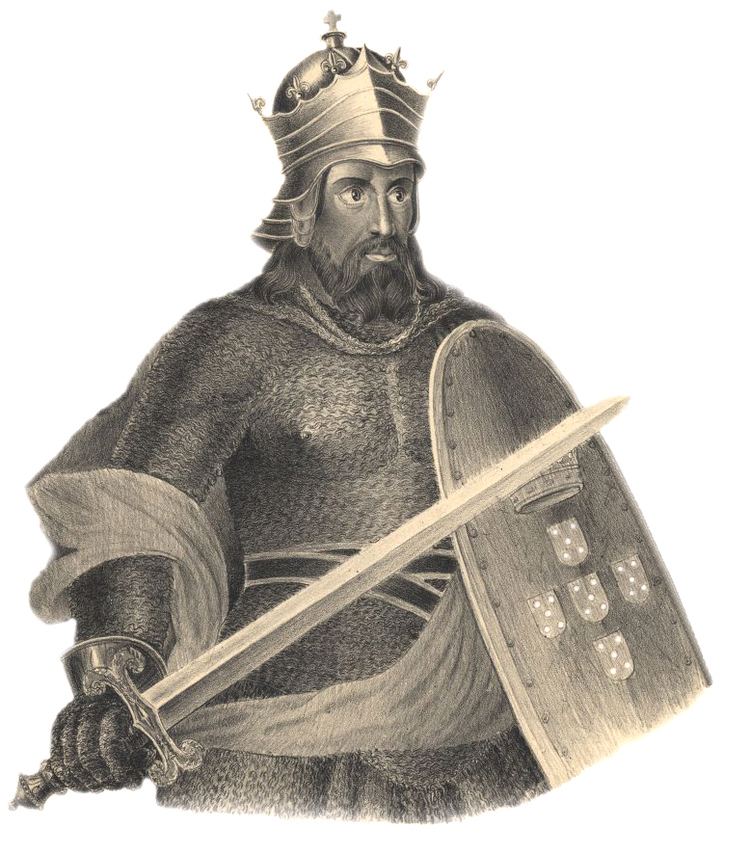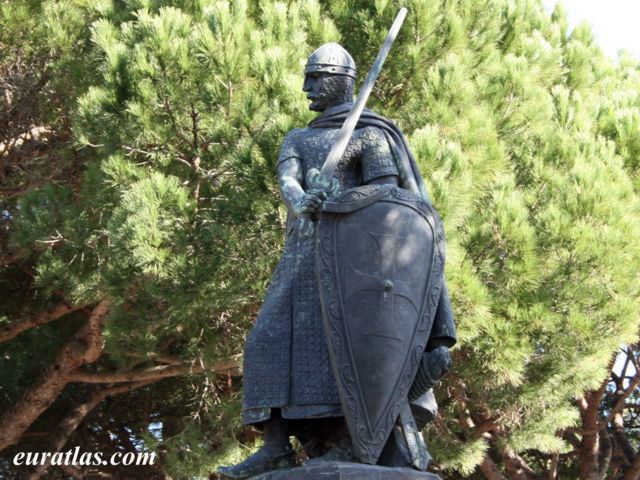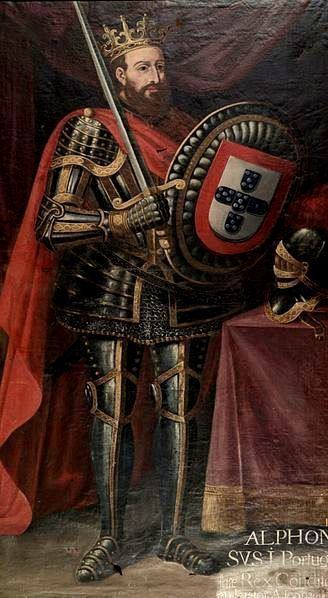Acclamation 26 July 1139 Name Afonso of | Predecessor Henry | |
 | ||
Reign 26 July 1139 – 6 December 1185 Reign 12 May 1112 – 25 July 1139 Regent Theresa, Countess of Portugal(1112–1126) Children Sancho I of Portugal, Urraca of Portugal Parents Henry, Count of Portugal, Theresa, Countess of Portugal Similar People Henry - Count of Portugal, Theresa - Countess of Portugal, Sancho I of Portugal, John I of Portugal, Afonso III of Portugal | ||
Statue of d afonso henrique king afonso i of portugal in guimares portugal
Afonso I (1106/ 25 July 1109 /1111 – 6 December 1185), nicknamed "the Conqueror" (Portuguese: O Conquistador), "the Founder" (O Fundador) or "the Great" (O Grande) by the Portuguese, and El-Bortukali [in Arabic البرتقالي] ("the Portuguese") and Ibn-Arrink [in Arabic ابن الرَّنك or ابن الرَنْق] ("son of Henry", "Henriques") by the Moors whom he fought, was the first King of Portugal. He achieved the independence of the southern part of the Kingdom of Galicia, the County of Portugal, from Galicia's overlord, the King of León, in 1139, establishing a new kingdom and doubling its area with the Reconquista, an objective that he pursued until his death, in 1185, after forty-six years of wars against the Moors.
Contents
- Statue of d afonso henrique king afonso i of portugal in guimares portugal
- Afonso I of Portugal
- From birth to rebellion Afonsos youth
- Sole count
- Kingship
- Scientific research
- Ancestors
- Descendants
- References

Afonso I of Portugal
From birth to rebellion: Afonso's youth

Afonso was the son of Henry of Burgundy and Theresa, the natural daughter of King Alfonso VI of León and Castile. According to Fernão Lopes' Crónica de Portugal de 1419, the future Portuguese king was born in Guimarães, which was at the time the most important political center of his parents. This was accepted by most Portuguese scholarship until Torquato de Sousa Soares proposed in 1990 Coimbra, the center of the county of Coimbra and another political center of Afonso's progenitors, as his birthplace, which caused a huge outrage in Guimarães and a polemic between this historian and José Hermano Saraiva. Almeida Fernandes later proposed Viseu as the birth place of Afonso basing himself on the Chronica Gothorum, which states Afonso was born in 1109, a position followed by José Mattoso in his biography of the king. Abel Estefânio has suggested a different date and thesis, proposing 1106 as the birth date and the region of Tierra de Campos or even Sahagún as likely birth places based on the known itineraries of counts Henry and Teresa.

The pair reigned jointly as count and countess of Portugal until Henry's death on 22 May 1112 during the siege of Astorga, after which Theresa reigned alone.

It is not known who was the tutor of Afonso. Later traditions, probably started with João Soares Coelho (a bastard descendant of Egas Moniz through a female line) in the mid-13th century and ampliated by later chronicles such as the Crónica de Portugal de 1419, asserted he had been Egas Moniz de Ribadouro, possibly with the help of oral memories that associated the tutor to the house of Ribadouto. Yet, contemporary documents, namely from the chancery of Afonso in his early years as count of Portucale, indicate according to José Mattoso that the most likely tutor of Afonso Henriques was Egas Moniz's oldest brother, Ermígio Moniz, who, besides being the senior brother within the family of Ribadouro, became the "dapifer" and "majordomus" of Afonso I from 1128 until his death in 1135, which indicates his closer proximity to the prince.
In an effort to pursue a larger share in the Leonese inheritance, his mother Theresa joined forces with Fernando Pérez de Trava, the most powerful count in Galicia. The Portuguese nobility disliked the alliance between Galicia and Portugal and rallied around Afonso. The Archbishop of Braga was also concerned with the dominance of Galicia, apprehensive of the ecclesiastical pretensions of his new rival the Galician Archbishop of Santiago de Compostela, Diego Gelmírez, who had claimed an alleged discovery of relics of Saint James in his town, as a way to gain power and riches over the other cathedrals in the Iberian Peninsula. In 1122, Afonso turned fourteen, the adult age in the 12th century. He made himself a knight on his own account in the Cathedral of Zamora in 1125, with the permission of her mother and her husband. After the military campaign of Alfonso VII against his mother in 1127, Afonso revolted against her and proceeded to take control of the county from its queen.
Sole count
In 1128, near Guimarães, at the Battle of São Mamede Afonso and his supporters overcame troops under his Count Fernando Peres de Trava of Galicia. Afonso exiled his mother to Galicia, and took over rule of the County of Portucale. Thus the possibility of re-incorporating Portugal (up to then known as Southern Galicia) into a Kingdom of Portugal and Galicia as before was eliminated and Afonso became sole ruler following demands for independence from the county's church and nobles. He also vanquished his mother's nephew, Alfonso VII of León, who came to her rescue, and thus freed the country from political dependence on the crown of his cousin of León. On 6 April 1129, Afonso Henriques dictated the writ in which he proclaimed himself Prince of Portugal.
Afonso then turned his arms against the persistent problem of the Moors in the south. His campaigns were successful and, on 25 July 1139, he obtained an overwhelming victory in the Battle of Ourique, and straight after was possibly unanimously proclaimed King of the Portuguese by his soldiers, establishing his equality in rank to the other realms of the Peninsula, although the first reference to his royal title dates from 1140. The first assembly of the Portuguese Cortes convened at Lamego (wherein he would have been given the crown from the Archbishop of Braga, to confirm his independence) is a 17th-century embellishment of Portuguese history.
Kingship
Independence from Alfonso VII of León's suzerainty, however, was not a thing he just could achieve militarily. The County of Portugal still had to be acknowledged diplomatically by the neighboring lands as a kingdom and, most importantly, by the Roman Catholic Church and the Pope. Afonso wed Mafalda of Savoy, daughter of Amadeus III, Count of Savoy, and sent ambassadors to Rome to negotiate with the Pope. He succeeded in renouncing the suzerainty of his cousin, Alfonso VII of León, becoming instead a vassal of the papacy, as the kings of Sicily and Aragon had done before him. In 1179 the bull Manifestis Probatum accepted the new king as vassal to the pope exclusively.
In Portugal he built several monasteries and convents and bestowed important privileges to religious orders. He is notably the builder of Alcobaça Monastery, to which he called the Cistercian Order of his uncle Bernard of Clairvaux of Burgundy. In 1143, he wrote to Pope Innocent II to declare himself and the kingdom servants of the church, swearing to pursue driving the Moors out of the Iberian Peninsula. Bypassing any king of León, Afonso declared himself the direct liege man of the papacy. Afonso continued to distinguish himself by his exploits against the Moors, from whom he wrested Santarém (see Conquest of Santarém) and Lisbon in 1147 (see Siege of Lisbon). He also conquered an important part of the land south of the Tagus River, although this was lost again to the Moors in the following years.
Meanwhile, King Alfonso VII of León (Afonso's cousin) regarded the independent ruler of Portugal as nothing but a rebel. Conflict between the two was constant and bitter in the following years. Afonso became involved in a war, taking the side of the Aragonese king, an enemy of Castile. To ensure the alliance, his son Sancho was engaged to Dulce, sister of the Count of Barcelona and Infanta of Aragon. Finally after winning the Battle of Valdevez, the Treaty of Zamora (1143) established peace between the cousins and the recognition by the Kingdom of León that Portugal was a sovereign kingdom.
In 1169 the now old Dom Afonso was possibly disabled in an engagement near Badajoz by a fall from his horse, and made prisoner by the soldiers of the king of León Fernando II also his son-in-law. From this time onward, the Portuguese king never rode a horse again, but it is not certain this was because of the disability: according to the later Portuguese chronistic tradition, this happened because Afonso would have to surrender himself again to Fernando II of León or risk war between the two kingdoms if he rode a horse. Portugal was obliged to surrender as his ransom almost all the conquests Afonso had made in Galicia (north of the Minho River) in the previous years.
In 1179 the privileges and favours given to the Roman Catholic Church were compensated. In the papal bull Manifestis Probatum, Pope Alexander III acknowledged Afonso as king and Portugal as an independent crown with the right to conquer lands from the Moors. With this papal blessing, Portugal was at last secured as a kingdom.
In 1184, the Almohad caliph Abu Yaqub Yusuf rallied a great Almohad force to retaliate against the Portuguese raids done since the end of a five year truce in 1178 and besieged Santarém, which was defended by the heir Sancho. The Almohad siege failed when news arrived the archbishop of Compostela had come to the defense of the city and Fernando II of León himself with his army. The Almohads ended the siege and their retreat turned into a rout due to panic in their camp, with the Almohad caliph being injured in the process (according to one version, because of a crossbow bolt) and dying on the way back to Seville. Afonso died shortly after, probably out of a sudden cause of death, on 6 December 1185. The Portuguese revere him as a hero, both on account of his personal character and as the founder of their nation. There are mythical stories that it took 10 men to carry his sword, and that Afonso wanted to engage other monarchs in personal combat, but no one would dare accept his challenge.
Scientific research
In July 2006, the tomb of the king (which is located in the Santa Cruz Monastery in Coimbra) was to be opened for scientific purposes by researchers from the University of Coimbra (Portugal) and the University of Granada (Spain). The opening of the tomb provoked considerable concern among some sectors of Portuguese society and IPPAR – Instituto Português do Património Arquitectónico (Portuguese State Agency for Architectural Patrimony). The government halted the opening, requesting more protocols from the scientific team because of the importance of the king in the nation's formation.
Ancestors
These are the known ancestors of Afonso Henriques, going back five generations.
Descendants
In 1146, Afonso married Mafalda, daughter of Amadeus III, Count of Savoy and Mahaut of Albon, both appearing together for the first time in May of that year confirming royal charters. They had the following issue:
Before his marriage to Mafalda, King Afonso fathered his first male son with Chamoa Gómez, daughter of Count Gómez Núñez and Elvira Pérez, sister of Fernando and Bermudo Pérez de Traba:
The extramarital offspring by Elvira Gálter were:
King Afonso was also the father of:
